 W
WAmphiaspididae is a family of extinct amphiaspidid heterostracan agnathans whose fossils are restricted to Lower Devonian marine strata of Siberia near the Taimyr Peninsula. In life, the amphiaspidids of Amphiaspididae are thought to be benthic animals that lived most of their lives mostly buried in the sediment of a series of hypersaline lagoons. Amphiaspids are easily distinguished from other heterostracans in that all of the plates of the cephalothorax armor are fused into a single, muff-like unit, so that the forebody of the living animal would have looked like a potpie with a pair of small, or degenerated eyes, with each flanked by a preorbital opening, and a simple, slit-like mouth.
 W
WAmphiaspidoidei is a taxon of extinct amphiaspidid heterostracan agnathans whose fossils are restricted to Lower Devonian marine strata of Siberia near the Taimyr Peninsula. In life, the amphiaspidids of Amphiaspidoidei are thought to be benthic animals that lived most of their lives mostly buried in the sediment of a series of hypersaline lagoons. Amphiaspids are easily distinguished from other heterostracans in that all of the plates of the cephalothorax armor are fused into a single, muff-like unit, so that the forebody of the living animal would have looked like a potpie or a hot waterbottle with a pair of small, or degenerated eyes flanked by preorbital openings, a pair of branchial openings for exhaling, and a simple, slit-like mouth.
 W
WAmphiaspis argo is the type species of the cyathaspidid taxon Amphiaspidida, and of the family Amphiaspididae. Its fossils are restricted to early Emsian-aged marine strata of the Taimyr Peninsula, Early Devonian Siberia. A. argo, as with all other amphiaspidids, is thought to have been a benthic filter feeder that lived on top of, or buried just below the surface of the substrate of hypersaline lagoon-bottoms.
 W
WAmphoraspis stellata is an amphiaspidid heterostracan in the family Amphiaspididae. Its fossils are restricted to early Devonian-aged marine strata of the Taimyr Peninsula, Siberia. A. stellata, as with all other amphiaspidids, is thought to have been a benthic filter feeder that lived on top of, or buried just below the surface of the substrate of hypersaline lagoon-bottoms.
 W
WCarcinosomatidae is a family of extinct arthropods in the class Eurypterida. These eurypterids are found from the Silurian to the Devonian periods. The family contains four genera; Carcinosoma, Eocarcinosoma, Eusarcana and Rhinocarcinosoma.
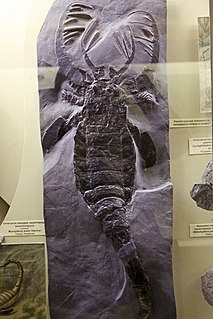 W
WCarcinosomatoidea is an extinct superfamily of eurypterids, an extinct group of chelicerate arthropods commonly known as "sea scorpions". It is one of the superfamilies classified as part of the suborder Eurypterina.
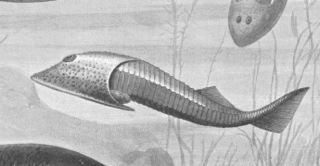 W
WCephalaspidomorphs are a group of jawless fishes named for Cephalaspis of the osteostracans. Most biologists regard this taxon as extinct, but the name is sometimes used in the classification of lampreys, because lampreys were once thought to be related to cephalaspids. If lampreys are included, they would extend the known range of the group from the Silurian and Devonian periods to the present day.
 W
WCornuata is an extinct taxon of jawless fish that lived in the Early Silurian to Late Devonian.
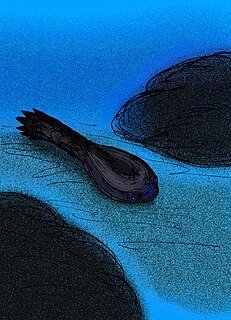 W
WCyathaspidiformes is an extinct order of heterostracan vertebrates known from extensive fossil remains primarily from Silurian to Early Devonian strata of Europe, and North America, and from Early Devonian marine strata of Siberia.
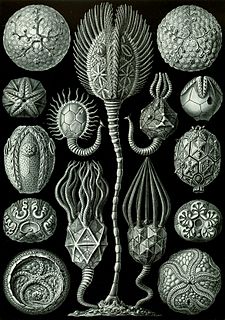 W
WCystoidea is a class of extinct crinozoan echinoderms, termed cystoids, that lived attached to the sea floor by stalks. They existed during the Paleozoic Era, in the Middle Ordovician and Silurian Periods, until their extinction in the Devonian Period.
 W
WDalmanitidae is a family of trilobites in the order Phacopida that lived from the Floian (Ordovician) to the Devonian and includes 33 genera.
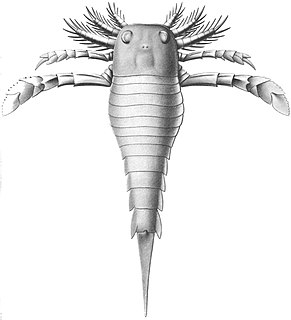 W
WDolichopteridae is an extinct family of eurypterids that lived in the Silurian and Devonian periods.
 W
WErieopterus is a genus of prehistoric eurypterid found in Silurian to Devonian-aged marine strata of Europe and North America. The genus contains eight species from the Silurian to the Devonian, recovered from both North America and Europe.
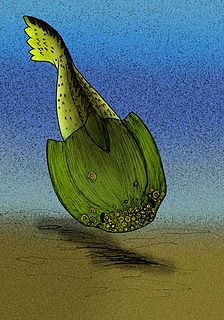 W
WGabreyaspididae is a family of extinct amphiaspidid heterostracan agnathans whose fossils are restricted to Lower Devonian marine strata of Siberia near the Taimyr Peninsula. In life, all amphiaspidids are thought to be benthic animals that lived most of their lives mostly buried in the sediment of a series of hypersaline lagoons. Amphiaspids are easily distinguished from other heterostracans in that all of the plates of the cephalothoracic armor are fused into a single, muff-like unit, so that the forebody of the living animal would have looked, in the case of gabreyaspidids, vaguely like a horseshoe crab with a pair of small, or degenerated eyes, with each flanked by a preorbital opening, and a simple, slit-like mouth positioned slightly ventrally.
 W
WGravicalymene is a genus of trilobites from the order Phacopida, suborder Calymenia. Gravicalymene has been a 'hot button' trilobite lately. The species that are currently in this genus have been in Calymene and Sthenocalymene. One thing that seems to be consistent with the genus Gravicalymene is that they sometimes occur in dolomitic limestone and that many occur in the Silurian age.
 W
WThe Hardieopteridae are a family of eurypterids, an extinct group of chelicerate arthropods commonly known as "sea scorpions". The family is one of two families contained in the superfamily Kokomopteroidea, which in turn is one of four superfamilies classified as part of the suborder Stylonurina. Hardieopterids have been recovered from deposits of Early Silurian to Late Devonian age in the United States and the United Kingdom.
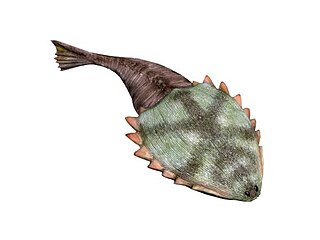 W
WHibernaspidoidei is a taxon of extinct amphiaspidid heterostracan agnathans whose fossils are restricted to Lower Devonian marine strata of Siberia near the Taimyr Peninsula. In life, hibernaspid amphiaspidids are thought to be benthic animals that lived most of their lives mostly buried in the sediment of a series of hypersaline lagoons. All amphiaspids are easily distinguished from other heterostracans in that all of the plates of the cephalothorax armor are fused into a single, muff-like unit, so that the forebody of the living animal would have looked like a potpie or a hot waterbottle with a pair of small, or degenerated eyes, a pair of branchial openings for exhaling, and, in the case of hibernaspids, a simple, slit-like mouth at the anterior end of a tube-like head.
 W
WHibernaspis is a genus of extinct amphiaspidid heterostracan agnathans whose fossils are restricted to Lower Devonian marine strata of Siberia near the Taimyr Peninsula. In life, species of Hibernaspis were thought to be benthic animals that lived most of their lives mostly buried in the sediment of a series of hypersaline lagoons. All amphiaspids are easily distinguished from other heterostracans in that all of the plates of the cephalothorax armor are fused into a single, muff-like unit, so that, in the case of Hibernaspis, the forebody of the living animal would have looked like a large guitar pic with serrated edges, with a pair of tiny, degenerated eyes, a pair of branchial openings for exhaling, and a simple, slit-like mouth at the anterior end.
 W
WHoloptychiidae is an extinct family of lobe-finned fishes which lived during the Devonian period. At least one genus, Laccognathus, is thought to have been amphibious.
 W
WKokomopteroidea is an extinct superfamily of eurypterids, an extinct group of chelicerate arthropods commonly known as "sea scorpions". It is one of four superfamilies classified as part of the suborder Stylonurina. Kokomopteroids have been recovered from deposits of Early Silurian to Late Devonian age in the United States and the United Kingdom.
 W
WLinguliformea is a subphylum of inarticulate brachiopods. These were the earliest of brachiopods, ranging from the Cambrian into the Holocene. They rapidly diversified during the Cambrian into the Ordovician, but most families became extinct by the end of the Devonian.
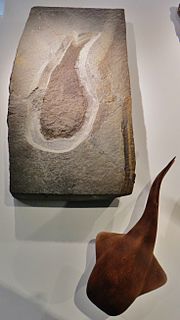 W
WLoganellia is a genus of jawless fish which lived between 430-370 million years ago, during the Silurian and Devonian periods of the Paleozoic. Loganellia belonged to the Thelodonti class and like other Thelodonts possessed scales instead of plate armor.
 W
WMeristella is an extinct genus of brachiopods found from the Late Silurian to the Late Devonian. They are characterized by a smooth oval shell and a prominent incurved beak on the pedicle valve. Meristella is placed in the family Meristellidae of the articulate brachiopod order Athyridida.
 W
WMiguashaiidae is an extinct family of prehistoric coelacanth fishes which lived during the Devonian period.
 W
WMonograptidae is an extinct family of graptolites of the Order Graptoloidea. Monograptids have only one row of thecae per stipe, unlike the biserial graptolites which have two opposing rows of thecae per stipe.
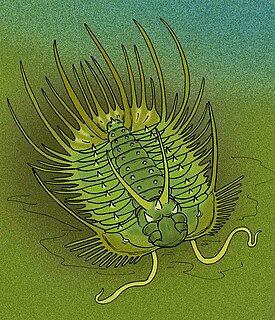 W
WOdontopleura is a genus of spinose odontopleurid trilobite in the family Odontopleuridae, and is the type genus of that family and of Odontopleurida. The various species are found in Upper Ordovician to Middle Devonian marine strata throughout the world. The best studied fossils are of the type species, O. ovata, from the Wenlock-aged Liteň Formation in Loděnice, in Bohemia, Czech Republic, and, southeastern Gotland, of Sweden.
 W
WOlbiaspididae is a family of extinct amphiaspidid heterostracan agnathans whose fossils are restricted to Lower Devonian marine strata of Siberia near the Taimyr Peninsula. In life, all amphiaspidids are thought to be benthic animals that lived most of their lives mostly buried in the sediment of a series of hypersaline lagoons. Amphiaspids are easily distinguished from other heterostracans in that all of the plates of the cephalothoracic armor are fused into a single, muff-like unit, so that the forebody of the living animal would have looked, in the case of olbiaspidids, vaguely like a hot water bottle with a pair of small, or degenerated eyes, with each flanked by a preorbital opening, and a simple, slit-like mouth positioned at the anteriormost portion of the cephalothoracic armor.
 W
WOrmoceras is an actinocerid nautiloid genus and type for the family Ormoceratidae, found in North America from the late Chazyan through the early Cincinnatian of the Middle and Upper Ordovician, but which continued through the Devonian worldwide.
 W
WOsteolepidae is a family of prehistoric lobe-finned fishes which lived during the Devonian period.
 W
WPalaeoconchus is a genus of microconchid tubeworms. Their tubes have pseudopunctae penetrating the tube wall. Tubes lumen is smooth. Palaeoconchus occurs in the Late Ordovician of Baltica and Avalonia. In the Devonian it had a global distribution.
 W
WPlacodermi is a class of armoured prehistoric fish, known from fossils, which lived from the Silurian to the end of the Devonian period. Their head and thorax were covered by articulated armoured plates and the rest of the body was scaled or naked, depending on the species. Placoderms were among the first jawed fish; their jaws likely evolved from the first of their gill arches. Placoderms are thought to be paraphyletic, consisting of several distinct outgroups or sister taxa to all living jawed vertebrates, which originated among their ranks. This is illustrated by a 419-million-year-old fossil, Entelognathus, from China, which is the only known placoderm with a type of bony jaw like that found in modern bony fishes. This includes a dentary bone, which is found in humans and other tetrapods. The jaws in other placoderms were simplified and consisted of a single bone. Placoderms were also the first fish to develop pelvic fins, the precursor to hindlimbs in tetrapods, as well as true teeth. Paraphyletic groupings are problematic, as one can not talk precisely about their phylogenic relationships, their characteristic traits and complete extinction. 380-million-year-old fossils of three other genera, Incisoscutum, Materpiscis and Austroptyctodus, represent the oldest known examples of live birth. In contrast, one 2016 analysis concluded that placodermi are likely monophyletic.
 W
WPsammmosteida also called as Psammosteoidei is a suborder of pteraspidid heterostracan agnathans. The psammosteids had broad, flattened bodies, suggesting a predominantly benthic habit. The earliest unequivocal psammosteid is Drepanaspis of Early Devonian Germany, which is either included in the family Psammosteidae, or placed within its own family, Drepanaspididae. If the late Silurian/Early Devonian Weigeltaspis is a psammosteid, as opposed to being a traquairaspid, then that genus, instead, would be the oldest psammosteid. However, its placement within Heterostraci remains a matter of debate. Other notable psammosteids include Psammosteus, and Obruchevia, two genera of enormous species with dorsal shields around one meter in diameter. The Psammosteids were the only heterostracans to survive to the end of the Devonian, where they finally perish during the Hangenberg event.
 W
WPteraspidiformes is an extinct order of heterostracan agnathan vertebrates known from extensive fossil remains primarily from Early Devonian strata of Europe and North America, and from Upper Silurian Canada.
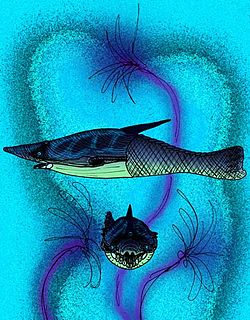 W
WPteraspidoidei is an extinct suborder of heterostracan vertebrates. It contains the more derived taxa within Pteraspidiformes, such as Pteraspis and Errivaspis, though, some protopteraspidids, such as Doryaspis and Panamintaspis, share various features with these derived pteraspidids.
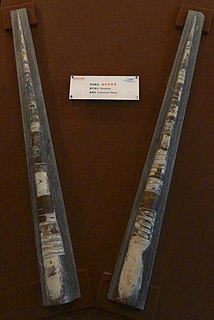 W
WSinoceras is an extinct genus of nautiloids from China included in the family Orthoceratidae that lived from the middle Ordovician until the Devonian. The type species, S. chinense, was originally described as "Orthoceras chinense," but then was promoted by Shimizu and Obata to its own genus, Sinoceras, in 1935.
 W
WTraquairaspis is a genus of extinct heterostracan agnathan fish known from the Silurian and Early Devonian periods. It is predominantly known from Late Silurian fluvial deposits from Wales and England: some species were also found in shallow water marine environment in Canada and North America.
 W
WTrimerophytopsida is a class of early vascular plants from the Devonian, informally called trimerophytes. It contains genera such as Psilophyton. This group is probably paraphyletic, and is believed to be the ancestral group from which both the ferns and seed plants evolved. Different authors have treated the group at different taxonomic ranks using the names Trimerophyta, Trimerophytophyta, Trimerophytina, Trimerophytophytina and Trimerophytales.
 W
WWaeringopteridae is a family of eurypterids, an extinct group of aquatic arthropods. The Waeringopteridae is the only family classified as part of the superfamily Waeringopteroidea, which in turn is classified within the infraorder Diploperculata in the suborder Eurypterina. The earliest known member of the group, Orcanopterus, has been recovered from deposits of Katian age and the latest known surviving member, Grossopterus, has been recovered from deposits of Siegenian age. The name Waeringopteridae is derived from the type genus Waeringopterus, which is named in honor of eurypterid researcher Erik N. Kjellesvig-Waering.
 W
WWeigeltaspis is a genus of extinct heterostracan agnathan fish known from the Late Silurian and Early Devonian periods. Fossils are known primarily from Early Devonian-aged marine strata of Europe and Canada. Fragments and disarticulated plates of what may be of Weigeltaspis are known from Late Silurian-aged marine strata of Arctic Canada. Rare articulated fossils, plus the overall anatomy of its plates suggest the living animals were, at least superficially, similar to psammosteids, some authorities, such as Tarlo, place them within Psammosteida. Because the ornamentation on the plates and scales are very similar to the ornamentation seen on the plates and scales of Traquairaspis to the point of constant confusion, other authorities follow the lead of Obruchev, and place Weigeltaspis within Traquairaspidiformes. Still other authorities remain unconvinced of either side, and, instead, follow Denison's lead to simply treat Weigeltaspis as incertae sedis.
 W
WThe zosterophylls are a group of extinct land plants that first appeared in the Silurian period. The taxon was first established by Banks in 1968 as the subdivision Zosterophyllophytina; they have since also been treated as the division Zosterophyllophyta or Zosterophyta and the class or plesion Zosterophyllopsida or Zosteropsida. They were among the first vascular plants in the fossil record, and had a world-wide distribution. They were probably stem-group lycophytes, forming a sister group to the ancestors of the living lycophytes. By the late Silurian a diverse assemblage of species existed, examples of which have been found fossilised in what is now Bathurst Island in Arctic Canada.
 W
WZosterophyllum was a genus of Silurian-Devonian vascular land plants with naked branching axes on which usually kidney-shaped sporangia were arranged in lateral positions. It is the type genus for the group known as zosterophylls, thought to be part of the lineage from which modern lycophytes evolved. More than 20 species have been described.